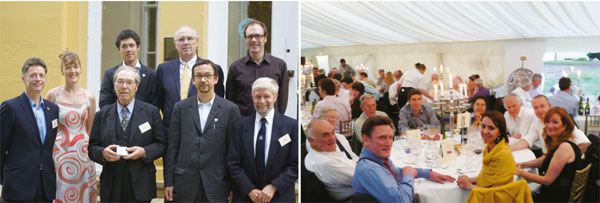The British Horological Institute (BHI) was founded in 1858, and could possibly be the oldest trade organisation of its kind in the world. What is completely certain is that its trade magazine, Horological Journal, is the longest continually published journal in the world for any trade. It has been published every single month since September 1858, without any breaks at all, wars or no wars.
And so the BHI felt fully justified in setting up a huge celebration of these enviable facts during 7th - 9th June 2008, at their majestic headquarters in Upton Hall, its small stately home outside Newark in Nottinghamshire. What a gathering it was, with distinguished (paying) guests from far and wide.
Mark Mills, chairman of the BHI, opened the proceedings on Saturday 7th June, and then introduced Viscount Midleton (the 12th in line, and known to all as Alan) who is curator of its fine watch collection and librarian (over 5,000 books and also magazine runs to look after). He is giving an account of the history of the BHI in the Horological Journal (HJ) in recent successive issues, and he gave an entertaining summary of it. The BHI formally came into being at a meeting of the founders in a modest room above the Belvedere Tavern in Pentonville (Islington area today, in London) on 15th June 1858. Your correspondent can confirm that the pub and the room above (still modest) remain there today.

George Daniels, centre, surrounded by the Frodsham team. Stephen Forsey, in the blue shirt, in the banquet tent.
Much of the first afternoon was devoted to the unveiling of the Anniversary Clock. This was the work over four years of a team of mainly amateur clockmakers, under the guidance of James Armfield, a Fellow of the BHI, and also frequent contributor to the HJ, and it now stands in the impressive main hall at Upton Hall, which means that no visitor can miss the enjoyment and perfection of it. It is a Three Pendulum timepiece, and is endowed with two special features, which together provide a short-term accuracy of a fraction of a second a year. Its three pendulums are arranged to oscillate in resonance; I quote Armfield: “The sapphire and zirconium knife-edge suspensions are arranged in an equilateral triangle, and the stainless steel seconds pendulums (each one is about one metre long) oscillate towards and away from each other in unison. This arrangement allows any vibrations that would otherwise affect the single pendulum to be trigonometrically cancelled out by the remaining pair.”
The second unique feature of the Anniversary Clock is its escapement. Again I quote: “It works in three dimensions, supplying an impulse to each pendulum in turn, and has nothing at all to do with the gear train. The locking is applied independently by a very light lever, and the energy required to unlock it remains absolutely constant from one beat to the next. Couple this constancy with the stability of a gravity-driven impulse, and one gets absolute regularity from the pendulums.”
Distinguished speakers decorated the next day’s agenda. Dr George Daniels, by now surely the grand old man of horology, opened the proceedings in characteristically bombastic style, and forcefully reminded his audience of some 150 people from all over the world that the hand watchmaker needs little more than a lathe, a small jig-borer, and patience, to produce beautiful, technical watches, and went on to commend the achievements so far of some speakers that were to follow: John McGonigle, Roger Smith, the Charles Frodsham team (who launch their first English-made wristwatches early in summer 2009), Peter Speake-Marin, Volker Vyskocil (a movement designer from Poland), Gideon Levingston (of Carbontime), Stephen Forsey (about experimental watch technology), and Alexander Schmiedt (Montblanc).
The third and last day, 9th June, provided a fascinating series of more technical talks, seminars and workshops. A leading light during the preparation of all the celebrations was Justin Koullapis, Technical Editor of the HJ. Afterwards he commented on the event and its significance: “The overriding feedback is that the strength of horology in Britain has always been its diversity. British makers have historically refused to be compartmentalised. It is this diversity that allowed makers here to flourish and to advance the science for the rest of the world… there is a re-awakening of the horological world’s awareness of these isles. On this positive note, all are urged to participate in this awakening. For 150 years, the BHI has been the focal point of this diversity, and it must surely remain so.”
Words well said.
Source: Europa Star December-January 2009 Magazine Issue





